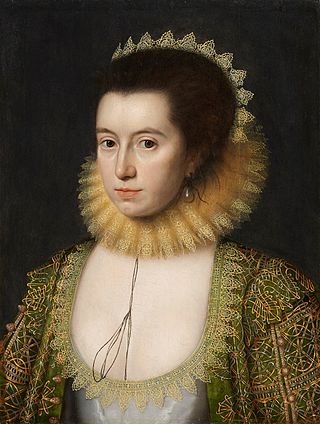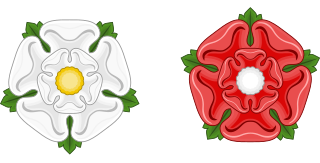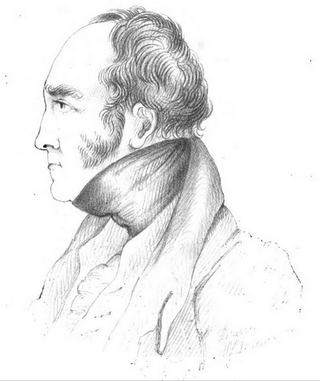Related Research Articles

Gildas — also known as Gildas Badonicus, Gildas fab Caw and Gildas Sapiens — was a 6th-century British monk best known for his religious polemic De Excidio et Conquestu Britanniae, which recounts the history of the Britons before and during the coming of the Saxons. He is one of the best-documented figures of the Christian church in the British Isles during the sub-Roman period, and was renowned for his Biblical knowledge and literary style. In his later life, he emigrated to Brittany, where he founded a monastery known as Saint-Gildas-de-Rhuys.

Lady Anne Clifford, Countess of Dorset, Pembroke and Montgomery, suo jure 14th Baroness de Clifford was an English peeress. In 1605 she inherited her father's ancient barony by writ and became suo jure 14th Baroness de Clifford. She was a patron of literature and as evidenced by her diary and many letters was a literary personage in her own right. She held the hereditary office of High Sheriff of Westmorland which role she exercised from 1653 to 1676.

Ruthin is a market town and community in Denbighshire, Wales, in the south of the Vale of Clwyd. It is Denbighshire's county town. The town, castle and St Peter's Square lie on a hill, skirted by villages such as Pwllglas and Rhewl. The name comes from the Welsh rhudd (red) and din (fort), after the colour of sandstone bedrock, from which the castle was built in 1277–1284. The Old Mill, Ruthin, is nearby. Maen Huail, a registered ancient monument associated with King Arthur and with Hueil mab Caw, the brother of the historian Gildas, stands in St Peter's Square.

The Battle of Northampton was fought on 10 July 1460 near the River Nene, Northamptonshire. It was a major battle of the Wars of the Roses. The opposing forces were an army led by nobles loyal to King Henry VI of the House of Lancaster, his Queen Margaret of Anjou and their six-year-old son Edward, Prince of Wales, on one side, and the army of Edward, Earl of March, and Warwick the Kingmaker on the other. The battle was the first in which artillery was used in England.
In Christianity, a collegiate church is a church where the daily office of worship is maintained by a college of canons, a non-monastic or "secular" community of clergy, organised as a self-governing corporate body, headed by a dignitary bearing a title which may vary, such as dean or provost.
Godfrey Goodman, also called Hugh; was the Anglican Bishop of Gloucester, and a member of the Protestant Church. He was the son of Godfrey Goodman (senior) and Jane Croxton, landed gentry living in Wales. His contemporaries describe him as being a hospitable, quiet man, and lavish in his charity to the poor.

John Hastings, 2nd Earl of Pembroke, was a fourteenth-century English nobleman and soldier. He also held the titles of Baron Abergavenny and Lord of Wexford. He was born in Sutton Valence, the son of Laurence Hastings, 1st Earl of Pembroke, and Agnes Mortimer, Countess of Pembroke. His father died when John Hastings was around one year old, and he became a ward of King Edward III while remaining in his mother's care. The King arranged for John to marry Edward's daughter Margaret in 1359, which drew John into the royal family. However, Margaret died two years later. John Hastings inherited his father's earldom, subsidiary titles and estates in 1368. The same year, he made a second marriage, to Anne, daughter of Walter, Lord Mauny. The following year, Pembroke began the career in royal service that continued for the rest of his life.
The Denbigh, Ruthin and Corwen Railway was a standard gauge railway line that connected Corwen with Denbigh via Ruthin in North Wales.

Ruthin School is a private day and boarding school located on the outskirts of Ruthin, the county town of Denbighshire, North Wales. It is over seven hundred years old, making it one of the oldest schools in the United Kingdom. Originally a school for boys, it has been co-educational since 1990.

Gabriel Goodman became the dean of Westminster on 23 September 1561 and the re-founder of Ruthin School, in Ruthin, Denbighshire. In 1568 he translated the “First Epistle to the Corinthians" for the “Bishops' Bible” and assisted Dr. William Morgan with his translation of the Bible into Welsh. He is mentioned on the monument to William Morgan which stands in the grounds of St Asaph cathedral.

John Charles Barrell FBA FEA is a British scholar of eighteenth and early nineteenth century studies.

Edward Lowry Barnwell was a British antiquarian and schoolmaster who was headmaster of Ruthin School, Denbighshire for 26 years.

Richard Parry (1560–1623) was a Bishop of St Asaph and translator of the Bible to the Welsh language.
Dedwyddfa is a house in Bryn Goodman, Ruthin, Denbighshire, Wales. It is a Grade II listed building, dated 1886, built for the Cornwallis-West family of Ruthin Castle. Its design is attributed to the Chester architect John Douglas. It is one of a pair of houses, the other being Coetmor which was definitely designed by Douglas. Both houses had large gardens, and were well placed for access to the railway.
Geoffrey George Goodman was a British journalist, broadcaster and writer. Following periods on the News Chronicle and the Daily Herald, he was a senior journalist on the Daily Mirror from 1969 to 1986. Goodman was known as "the doyen of industrial correspondents" for his extensive contacts and prominent role covering British industrial disputes.

The Collegiate and Parochial Church of St Peter is the Anglican parish church of Ruthin, an ancient market town which lies within the Vale of Clwyd in Denbighshire, north east Wales. It is a greater church of the diocese of St Asaph and a Grade I listed building.
Maxwell Tulloch Dunlop was a senior Church of England priest. He was Archdeacon of Aston from 1955 to 1964.

Eubule Thelwall was a landowner and solicitor who held legal offices in North Wales and Cheshire, and the third son of John Thelwall of Bathafarn Park, Ruthin. In 1646 he served in the siege of Denbigh Castle and was sent by William Salesbury, the castle's governor, to Charles I to seek his permission to surrender. Thelwall married Marry Parry, the heiress of Nantclwyd estate in 1653 and instigated a complete rebuild of the building and of a second, smaller building in the nearby town of Ruthin: Nantclwyd y Dre, which is Wales's oldest dated timbered town house.
Robert Arthur Lloyd was a Welsh footballer who played as a full back. He played twice for his country, in 1891 and 1895. He later became a priest in the Church of England.

Joseph Ablett was a philanthropist and High Sheriff of Denbighshire, a county in Wales, in 1809.
References
- ↑ "A memoir of Gabriel Goodman ... with some account of Ruthin school, and the names of its most eminent scholars, etc: Also of Godfrey Goodman, D.D., bishop of Gloucester from the year 1624 to 1655" Newcome, R p46: Ruthin; Taliesin Press; 1825
- ↑ Alumni Oxonienses 1500–1714, Pritchard-Pyx
- ↑ "Chirk Castle Accounts, A.D. 1666–1753" Myddelton, W.M. p146: Manchester; Manchester University Press; 1931